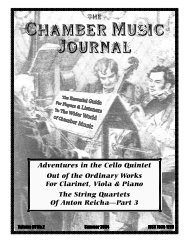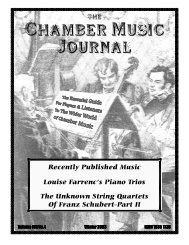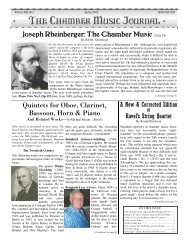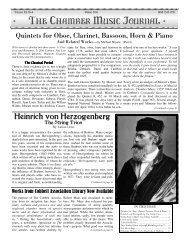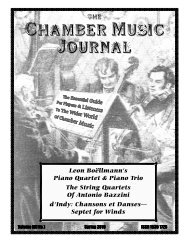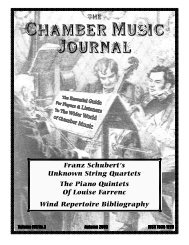Chamber Music Journal - Cobbettassociation.org
Chamber Music Journal - Cobbettassociation.org
Chamber Music Journal - Cobbettassociation.org
Create successful ePaper yourself
Turn your PDF publications into a flip-book with our unique Google optimized e-Paper software.
(Continued from page 5)<br />
Notice that playing all the notes correctly is not a top priority for<br />
sight-reading. Those notes you are able to grab in the heart of<br />
battle should of course be played as beautifully and as much in<br />
tune as possible. This will be much easier to do by following the<br />
Golden Rule and always listening to and imitating the other players<br />
in the chamber music group. Note that the top priorities of<br />
staying within the rhythm, the dynamics and the harmonic structure<br />
will often require that you leave out or change notes.<br />
Another priority that is important for most musicians that feel<br />
uncomfortable with sight-reading is “space-time”. This is not a<br />
reference to Einstein’s theory of relativity but to the ability to feel<br />
and sight-read the inherent space-time that lies between notes,<br />
groups of notes, and melodic phrases. Paradoxically, this spacetime<br />
is far more important to making beautiful music, whether<br />
sight-reading or performing it, than merely playing the notes.<br />
Watch the page in front of you but learn to relax and enjoy the<br />
others in the sight-reading or performing group. Let fly what is<br />
going on. Let the music soar. Remember that music is essentially<br />
spatial in nature; it takes place between and beyond the mere<br />
notes. The nature of sight-reading does not demand perfection.<br />
Accidents do occur. Don’t be frustrated by them. Enjoy the group<br />
and share the joy of tasting a piece of music for the first time.<br />
Choosing players and music for the sight-reading session:<br />
The most important ingredient for an enjoyable sight-reading session<br />
is good group vibrations, that is, good psychology: all participants<br />
must be able to feel at ease and to enjoy themselves.<br />
Tension, nervousness, disputes or any other type of negative feelings,<br />
if they arise, should immediately be resolved. This will<br />
rarely be a problem for groups that meet regularly. They have<br />
learned to adjust to each others musical idiosyncrasies, and can<br />
readily reach compromises. However, the musical horizons of the<br />
members of such groups can only expand if they also sight-read<br />
with other musicians and in other groupings.<br />
It can be of great benefit to learn from others that know more<br />
than we do. It can be of equally great benefit to help others increase<br />
their knowledge and experience. However, matching the<br />
choice of music to the experience levels of such mixed groups is<br />
obviously the most vital ingredient to assure a successful session.<br />
To break the ice, start with a fairly easy generally familiar or<br />
standard work. As mentioned in the problems section above,<br />
early renaissance music can sometimes serve this purpose although<br />
it usually requires that the counting ability of all participants<br />
is at an advanced level. <strong>Music</strong> from the early classical period,<br />
J.C. Bach for example, is also an excellent way to warm up.<br />
If some of the parts to the music contain technically challenging<br />
portions consider giving those parts out ahead of time. Do not<br />
pick pieces that will obviously frustrate any of the participants.<br />
Twentieth century atonal music is not to everyone’s taste.<br />
Avoid critical statements. You are not rehearsing! You are there<br />
to have a good time and to make sure all the others will have a<br />
good time. Be encouraging. If someone just sight-read a beautiful<br />
lick, nod approval. Help each other whenever possible. Slow<br />
down tempi to make it easier for another player to get through a<br />
critical passage. Skip over the beat or the measure that someone<br />
miscounted to keep the music flowing. Never assume that a mistake<br />
is someone else’s fault. Many mistakes occur because good<br />
group vibrations are missing. Just merely thinking critical<br />
thoughts can affect the group’s confidence level and lessen the<br />
group’s enjoyment.<br />
-6-<br />
Speaking while sight-reading<br />
The ability to speak while playing is a skill that all string players<br />
and pianists that want to sight-read well must learn. Since they<br />
are playing from a score, pianists should take the lead in helping<br />
lost players find their way back into the fold by telling them<br />
where to rejoin the group. In complex music, it is wise for all the<br />
players in a group to signal every rehearsal number or letter to<br />
each other. The ability to speak while playing is also of great<br />
benefit if the group has difficulty imitating each others style. It is<br />
easy to simply state suggestions such as: “Let’s try it much softer<br />
(or louder); Can you match my sound; Let me breath; Give me<br />
some rhythmic freedom here; Let’s use shorter notes; Let’s play<br />
more legato; I think I have a counter melody- let me cut through;<br />
Let’s take the second ending; That was so beautiful, let’s repeat”.<br />
Leading, signaling and eye contact<br />
As a general rule, the highest voiced instrument should assume<br />
the predominant leading and cue-giving role in a sight-reading<br />
session without a pianist: the first violin in an all string group, the<br />
flute in an all wind group, the first violin in a mixed string wind<br />
group. If a pianist is involved he should assume that role. Of<br />
course, if any other player has familiarity with the music or obviously<br />
has more sight-reading experience the highest voiced instrument<br />
or the pianist should share the role. Signaling is of great<br />
help. It can be done verbally: “Who starts on the down-beat<br />
Who has an up-beat (When a pianist is involved, he should always<br />
state how each movement of the work being read begins or<br />
restarts); I’ve got a pick up here; Hold it, bad page turn; I start<br />
with triplets.” The benefits of frequent eye contact throughout the<br />
sight-reading session cannot be overemphasized. It is not a skill<br />
that comes naturally. It requires that the eyes which are struggling<br />
to sight-read unfamiliar notes look up briefly from the page of<br />
music to meet the eyes of another musician and then find their<br />
way back to the right spot on that page. This skill can and should<br />
be practiced alone by frequently focusing the eyes on some other<br />
object in the room and refocusing on the music being played.<br />
Paradoxically, this skill, once learned, reduces significantly any<br />
tensions or fears that sight-reading often causes. It creates vibrant<br />
warmth among the players of the group and magically makes it<br />
far easier to play well together, that is, it helps to create good<br />
group vibrations.<br />
Avoiding breakdowns<br />
It is a very good idea to talk about how to handle breakdowns<br />
before the sight-reading begins unless the group wants the session<br />
to turn into a rehearsal. Breakdowns can be frustrating if there are<br />
too many of them. They often cause a debilitating erosion of<br />
group confidence. Obviously, they make it difficult to enjoy the<br />
music being sight-read. Some players prefer to first “taste” an<br />
unfamiliar work as a whole. Generally speaking this should be<br />
the goal of sight-reading. Others want to correct mistakes immediately<br />
or repeat a passage that was not played as well as they feel<br />
it should have been. A prime example of this is the wish of a<br />
player to repeat a solo or, in extreme cases of Soloitis, a single<br />
note that was misplayed. Therefore reach a compromise and decide<br />
what the group as a whole prefers. Sometimes individual<br />
parts can be rhythmically confusing causing one or more players<br />
to loose their way. Depending on the kind of music, it is often<br />
possible to listen your way back into the flow. If you are lost and<br />
can’t find your way back, simply ask the others, verbally or by<br />
some other signal for the next downbeat or the next rehearsal<br />
number: “I need a downbeat”; or “Tell me when we get to letter<br />
G”. If it becomes obvious that someone is lost but is not immedi-



